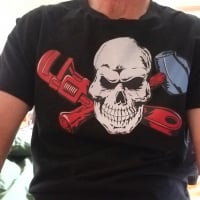Welcome! Here are the website rules, as well as some tips for using this forum.
Need to contact us? Visit https://heatinghelp.com/contact-us/.
Click here to Find a Contractor in your area.
Protecting against cool return.
Options

icy78
Member Posts: 404
Basically, why?
Water heaters heat cold water in everyone's house, without any mixing. And without any issues.
I've seen numerous domestic HW boilers inputting 50f water, no problem! No one even blinks at that setup.
So what's the big deal about return water temp.?
I think it's only an issue if the burner low fires, and the flame/fluegas is cooled below condensing . At high fire, no problem.
Ok, I'm ready for a beatdown!🙂
Water heaters heat cold water in everyone's house, without any mixing. And without any issues.
I've seen numerous domestic HW boilers inputting 50f water, no problem! No one even blinks at that setup.
So what's the big deal about return water temp.?
I think it's only an issue if the burner low fires, and the flame/fluegas is cooled below condensing . At high fire, no problem.
Ok, I'm ready for a beatdown!🙂
0
Comments
-
I'm not sure what you mean by "domestic HW boilers" but I think you mean water heaters which are throw-away items, though some are made of copper for condensing. You can't treat a boiler like a water heater. But you're right, cold return temperature is only an issue during an active burn. It's the excessively cool combustion gas temperatures that cause condensation.Contact John "JohnNY" Cataneo, NYC Master Plumber, Lic 1784
Consulting & Troubleshooting
Heating in NYC or NJ.
Classes0 -
...... well, the boilers I see are often Raypak from 200- 750000 BTU. And they are moving 20- 70 GPM through them and never any problem of boiler sooting or poor combustion, as long as it runs on high fire. (These are ribbon burners.)JohnNY said:I'm not sure what you mean by "domestic HW boilers" but I think you mean water heaters which are throw-away items, though some are made of copper for condensing. You can't treat a boiler like a water heater. But you're right, cold return temperature is only an issue during an active burn. It's the excessively cool combustion gas temperatures that cause condensation.
So 50^F in and 170 out.
Small pool heaters too. Some have those governer devices to keep 105-110 LEAVING water temp but as long as they fire hard, theres no problem.
I'm wondering if pushing inlet mixing is just a way for manufacturers of conventional atmospheric boilers, to get those boilers used in situations where low fire is an often seen firing rate. Because in that type of situation, inlet mixing might be a good thing.0 -
It probably has more to do with lower load periods of time and the thermostat getting satisfied before the supply temp gets much over 130 or 140 than the return temp directly.0
-
-
I think it has to do with the design of the heat exchanger. The small Raypak boilers have always had a bypass valve to help return temperatures.
All cold start boilers start out as condensing boilers, it matters how quickly they get above condensing temperatures, also that they run long enough to dry out the flue piping to prevent
condensation.
Some suggest tank type water heaters are built with "sloppy" somewhat inefficient heat exchange design so they can handle that mode of operation, Observe one running with cold water they drip and hiss until that flue passage warms sufficiently.
Flue temperature tells the story as well as low efficiency numbers.Bob "hot rod" Rohr
trainer for Caleffi NA
Living the hydronic dream2 -
that looks like one of those brick barbecues..0
-
Oops my bad!Steve Minnich said:Take a cast iron boiler and return 110* water to it and see how long it lasts. It’s not a marketing scheme. It’s based on true and tried science.
I bet your right Steve.
I realized after you posted the above, that I was thinking copper fin ,because those are what I've seen with low low inlet water temps.
I think theres only 4 CI boiler that i can remember( that we service at least) and those had a high return temp. and are PS piped.
So this conversation would be about copper fin boilers in low inlet temperature applications.
Lots of Lochinvar, Raypak.
0 -
hot_rod said:I think it has to do with the design of the heat exchanger. The small Raypak boilers have always had a bypass valve to help return temperatures. All cold start boilers start out as condensing boilers, it matters how quickly they get above condensing temperatures, also that they run long enough to dry out the flue piping to prevent condensation. Some suggest tank type water heaters are built with "sloppy" somewhat inefficient heat exchange design so they can handle that mode of operation, Observe one running with cold water they drip and hiss until that flue passage warms sufficiently. Flue temperature tells the story as well as low efficiency numbers.
Interesting pic @hotrod.
Yes I think that fluetemp is the main factor.
It could be 45 degree f EWT and if the flue was above condensing then no problem. I think.0
Categories
- All Categories
- 85.2K THE MAIN WALL
- 3.1K A-C, Heat Pumps & Refrigeration
- 55 Biomass
- 424 Carbon Monoxide Awareness
- 73 Chimneys & Flues
- 1.9K Domestic Hot Water
- 5.2K Gas Heating
- 129 Geothermal
- 160 Indoor-Air Quality
- 3.3K Oil Heating
- 61 Pipe Deterioration
- 884 Plumbing
- 5.9K Radiant Heating
- 376 Solar
- 14.7K Strictly Steam
- 3.2K Thermostats and Controls
- 59 Water Quality
- 49 Industry Classes
- 89 Job Opportunities
- 28 Recall Announcements



